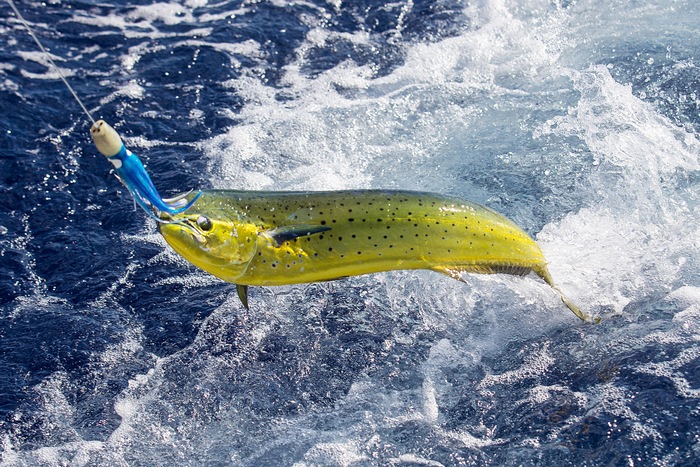Summer Destination: Waters Flourishing with Mahi-Mahi

From its playful name to its vivid tropical hue, mahi-mahi is something special—a true treat for any offshore angler.
So, what’s the best way to go about finding one? Read on as we explore the ins and outs of mahi-mahi, as well as a few ways to land this formidable “bull” of a catch.
What’s in a name?
Mahi-mahi means “very strong” in the Hawaiian language, a reference to the sheer size and force of this offshore whopper. It should perhaps come, then, as no surprise that mahi-mahi also goes by “bull dolphin,” in reference to its knack for being a struggle to catch… but rest assured. The neon-colored fish is not actually related to the mammalian bottlenose dolphins you might be more familiar with!
And then, of course, there’s another name—“dorado,” or Spanish for gold. The inspiration for this name is clear, as the mahi-mahi’s yellow coloring glistens brightly in the sunlight. It’s part of what makes the fish such a prized catch for many anglers—not only is it a big fish, but a beautiful one, too, surely worthy of a photo frame.
The search for mahi-mahi action
Finding mahi-mahi on your offshore adventures is a real treat… even if you’re not actually trying to catch one! Thanks to the fish’s famous “acrobatics,” it tends to put on a show for nearby boaters, flipping and jumping above the surface when it’s not speeding just beneath it. While the mahi-mahi’s eye-catching tropical colors seem perfectly in place off the coasts of Florida, Mexico or Hawaii, you don’t need to take a vacation to see one in action. Tagged mahi-mahi have traveled from the Florida Keys to New York and New Jersey in an amazing time, going just under 100 miles a day.
Of course, such fast-swimming also makes the mahi-mahi a famously big eater, gobbling up almost 6 percent of its total body weight, on average, per day.
Be sure to know what to look for when it comes to scoping out mahi-mahi action on your travels. Maybe you spot some bigger fish under a pretty clear surface, but they are bluer in hue, and don’t exhibit that classic yellow flash. Don’t give up yet—they might very well be mahi-mahi! This fish, in addition to its other unique attributes, is a famous shade shifter. When relaxed in the water, it will often look blue or teal, taking on the familiar yellow look by the surface, when eating, or in the midst of a catch.
Landing the catch
So, how do you catch a fish that moves as quickly as the mahi-mahi? Move with it! Trolling at around five knots is a good speed to start with. Keep an eye out for long spans weed line and other water debris, and you might just find your mahi-mahi. When you do, live ballyhoo is highly recommended as your bait as it’s sure to draw up some attention for hungry fish, while keeping the smaller catches at bay. Then, be prepared to work for your catch—they don’t call it a bull dolphin for nothing, but that’s just part of the fun.
When all’s said and done…
If you decide to bring home your mahi-mahi, look forward to a deliciously fresh, bright tropical meal—because while mahi-mahi may be strong, its flavor is much milder, on the sweeter side of things. Many chefs like to play off the mahi-mahi’s mild profile using tangy citrus elements like lemon and lime. Opt for a fun, summery dish like fish tacos and gather up a crowd!
Mahi-mahi’s the kind of fish to make your day as an angler… so get out there and have some fun with it! Be sure to share your own personal mahi-mahi records in the comments below, too.
Bookmark & Share
Previous Article
Next Article
